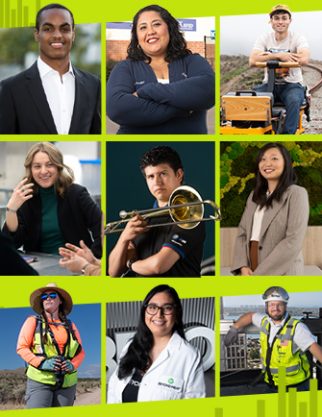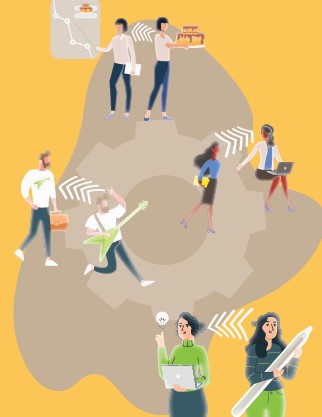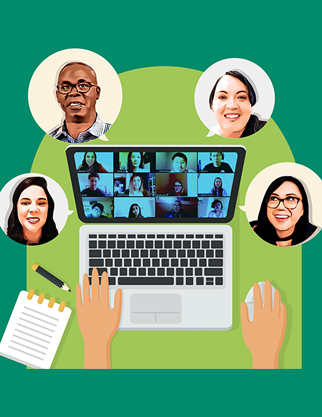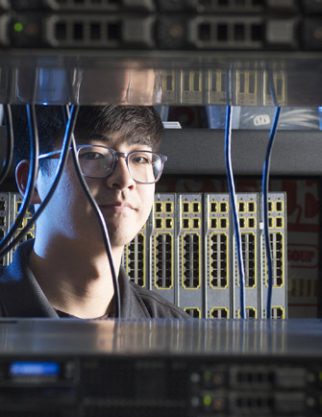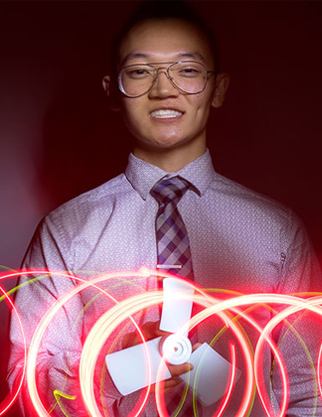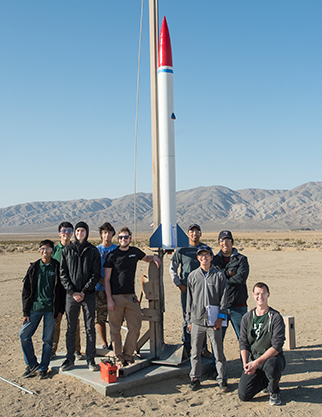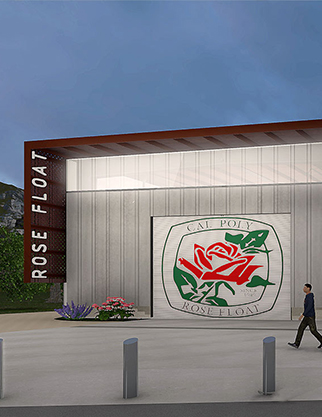The Covid-19 pandemic has affected the way nearly every American works. Whether jobs are lost or simply moved to another location, the change to the workforce will have a lasting effect. Cal Poly Pomona faculty and alumni have certainly not been spared.
Restaurateur Russ Bendel Jr. (’05, hospitality management) has seen his businesses closed completely, open for takeout only, and then offering outdoor dining — all at various times in the last year.
The pandemic seriously curtailed school tours at Tanaka Farms, but farmer Glenn Tanaka (’78, agribusiness) also saw an increase in produce sales as stay-at-home orders inspired people to cook more.
Clint Hostetler (’13, mechanical engineering) changed jobs during the pandemic and has yet to step inside an office at Cervélo Cycles.
For lecturer Kira Blumberg, it has meant teaching viola remotely. And fifth grade teacher Belén Pinedo (’11, liberal studies) wrangles students from her home in El Monte.
For realtor Thomas Ryan (’10, sociology), the change hasn’t been too much of a problem, and business has been booming as folks look to upgrade their new work environment.
Richard Lay (’89, physics) found out what it is like to do rocket science for the Jet Propulsion Lab from his home in Glendora.
Noam Saragosti (’14, architecture) and Juhee Park (’14, architecture) have figured out ways foster the separation of their living and work spaces, transforming their dining room into an office and living room into a conference room by day, then changing it back at night.
Russ Bendel Jr. (’05, hospitality management)
Owner of Vine, San Clemente; Ironwood, Laguna Hills; Olea, Newport Beach; Sapphire, Laguna Beach; and The Pantry, Laguna Beach.
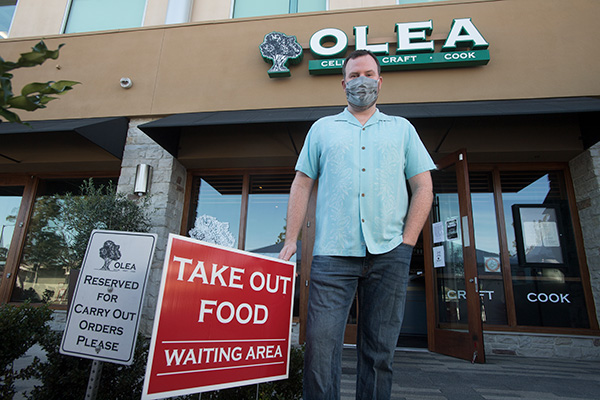 I think we have learned a lot about how to pivot and adapt since March 2020.
I think we have learned a lot about how to pivot and adapt since March 2020.
We have spent more time enhancing our digital presence and finding ways to streamline ordering and communication with our communities during the pandemic.
We will continue to keep this top of mind going forward, in addition to finding more exciting ways to enhance our guests’ dining experiences when they are able to return for a complete onsite experience at all of our restaurants.
Glenn Tanaka (’78, agribusiness)
Owner of Tanaka Farms in the city of Irvine
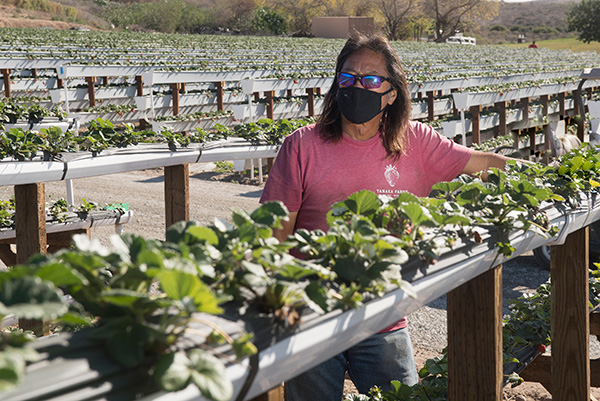 The pandemic really has improved our customer relations; they’ve seen how we were able to pivot and change our processes to accommodate the health codes and restrictions to make things safer. They’ve grown more confident in our processes and what we do.
The pandemic really has improved our customer relations; they’ve seen how we were able to pivot and change our processes to accommodate the health codes and restrictions to make things safer. They’ve grown more confident in our processes and what we do.
It’s actually helped our business relations with our customers. Our business has improved. People are cooking at home and they want to eat. So, it’s business as usual, maybe just in a different fashion. We’re just as busy as we were before.
Clint Hostetler (’13, mechanical engineering)
Development Engineer, Cervelo Cycles

In July 2020, I started as a development engineer for Cervélo Cycles with the company’s headquarters still in Canada, pending a move to Southern California. My entire on-boarding was done remotely without being available to travel to their offices in Canada.
The only interaction I have had thus far with many of my colleagues has been via Google meet, creating an interesting dynamic of meshing with a new team. I have had to try to sort out different personalities and work habits while being three time zones away. Like many, I find the merit in this style of communication but miss the ability to hold prototype parts and pass them around to help get a better sense of a design. Due to my role in testing, my primary responsibilities are traditionally very hands-on and I have had to be flexible and utilize my skillset as much as possible within their remote structure while still finding my footing.
I believe the events of the COVID-19 pandemic have emphasized the importance of internal communication within companies. With employees spread across the globe and the inability for the development group to travel to manufacturing facilities, being clear and concise is more important than ever. I hope this can be a positive habit that is taken into the future. It’s been an interesting journey from March until now. I am excited and hopeful to finally get back into an office setting with the ability to go on group rides and happy hours.
Kira Blumberg
Viola instructor, Cal Poly Pomona music department
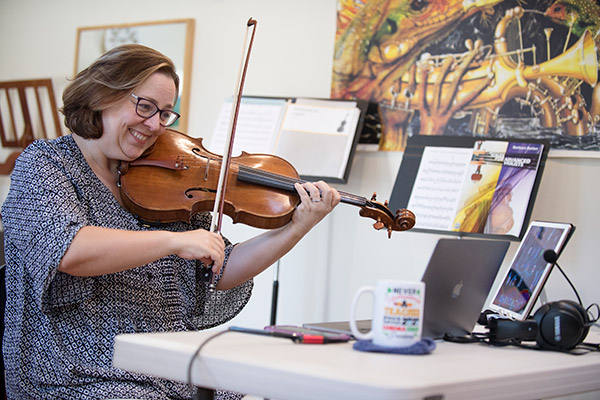 Music has always been communal — humans benefit from making music together. In this time of relative isolation, the drive to make music remains. As teachers, we are figuring out how to connect with each other and with our students in this new environment. We still rely on highly-attuned engagement, but we are adapting to the challenges of distance learning, including greater use of the resources provided by technology and other specialized equipment. Students are accustomed to the reward of playing in ensembles or privately for one another, and collaborative music making has shifted for now.
Music has always been communal — humans benefit from making music together. In this time of relative isolation, the drive to make music remains. As teachers, we are figuring out how to connect with each other and with our students in this new environment. We still rely on highly-attuned engagement, but we are adapting to the challenges of distance learning, including greater use of the resources provided by technology and other specialized equipment. Students are accustomed to the reward of playing in ensembles or privately for one another, and collaborative music making has shifted for now.
The practicing we do by ourselves doesn’t change; we play a passage, we assess what we played, and we formulate a plan to make it better. My goal is to continue emphasizing and developing my students’ skill and passion so that they will be ready to re-enter the live musical world as soon as we are able.
Belén Pinedo (’11, liberal studies)
Fifth grade teacher, Azusa Unified School District

Teaching elementary school children remotely has created many challenges for educators. First, our workload has increased drastically. I’m not only responsible for teaching the curriculum, but I am now also responsible for creating adequate digital material that all my students can access. My lessons need to be thoughtfully designed to be short and effective in order to maximize student engagement. On the other hand, when we return to in-person instruction I will have digital materials ready to use. Additionally, my students will be able to execute more research projects and create effective presentations without learning the technology first.
Thomas Ryan (’10, sociology)
Realtor
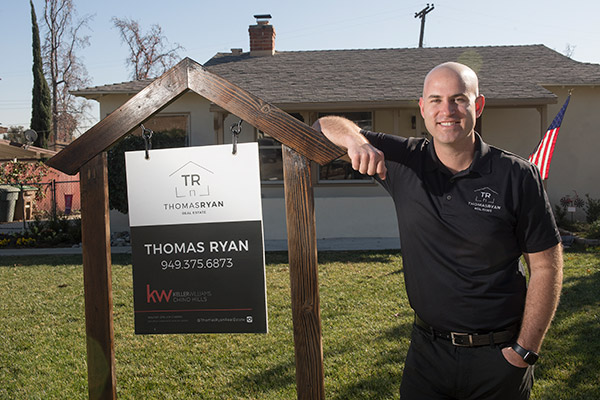 While there have been many changes to our industry over the past 10 months, realtors have become more and more mobile and office independent over the past years as technology has developed. For instance, I personally have worked out of my home office for the past four years.
While there have been many changes to our industry over the past 10 months, realtors have become more and more mobile and office independent over the past years as technology has developed. For instance, I personally have worked out of my home office for the past four years.
What we have integrated into our business are video calls in place of meetings we traditionally would have done in person, systems to safely track and record buyers viewing property, visual technologies such as 3D or Virtual Tours for home previewing, and a massive shift towards digital and video marketing. Overall, I believe there are many implementations that were fast-tracked due to COVID-19, and we will carry them into our future business norms.
Richard Lay (’89, physics)
Project Manager, Jet Propulsion Laboratory
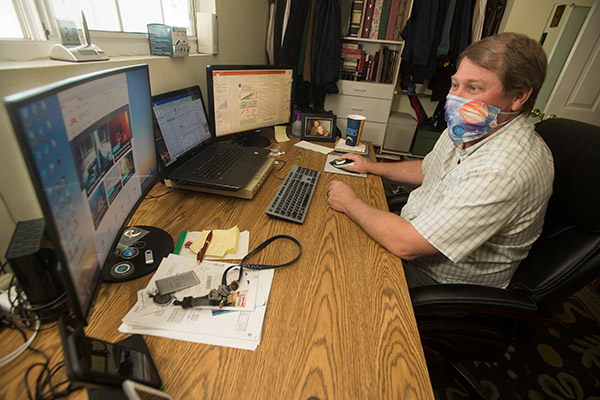
Working from home is a huge shift in how we do business. But the surprising thing is how productive people can be. The fact that we have been so productive makes me think we will continue to have this work-at-home norm continue on long term. A lot of our science team members have a history of remote work since a lot of what they do is writing detailed papers and studying data and information. They’ve been doing work off site for a long time.
The collaboration part is the real challenge. Like a lot of businesses, hallway conversations and water cooler discussions are a big part of moving forward and understanding what’s going on, and that’s the real thing we have lost.
Noam Saragosti (’14, architecture)
Director of VDL Neutra House, CPP ARC Lecturer
Juhee Park (’14, architecture)
Project Manager at Escher GuneWardena Architecture
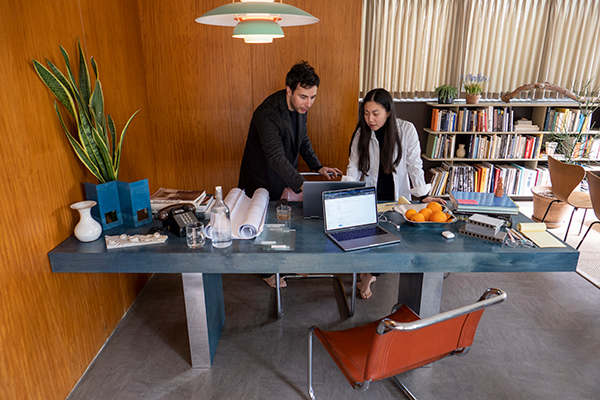
Working from home has led us to rethink our very basic tendencies and habits both spatially and virtually. Our dining room functions as an office during the day, and transforms back to dining in the evening. Our office becomes a kind of “phone booth” to take private calls, and our living room often serves as a conference room. Despite the physical distance, we’ve all adapted to new modes of communication and collaboration, using virtual white boards, Teams, Zoom, etc. One of the positive outcomes has been the ease of visual communication with students, colleagues, and clients. We now have the ability to share architectural drawings, zoom in/out, draw over them, and quickly pull up references and other documents while all participants are viewing the same information at the same scale at the same time.
